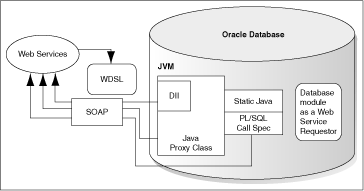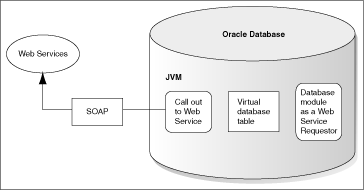| Oracle® Database Java Developer's Guide, 11g Release 2 (11.2) Part Number E10588-01 |
|
|
View PDF |
| Oracle® Database Java Developer's Guide, 11g Release 2 (11.2) Part Number E10588-01 |
|
|
View PDF |
This chapter provides an overview of database Web services and discusses how to call existing Web services. This chapter contains the following sections:
Web services enable application-to-application interaction over the Web, regardless of platform, language, or data formats. The key ingredients, including Extensible Markup Language (XML), Simple Object Access Protocol (SOAP), Web Services Description Language (WSDL), and Universal Description, Discovery, and Integration (UDDI), have been adopted across the entire software industry. Web services usually refer to services implemented and deployed in middle-tier application servers. However, in heterogeneous and disconnected environments, there is an increasing need to access stored procedures, as well as data and metadata, through Web services interfaces.
The Database Web services technology is a database approach to Web services. It works in the following two directions:
Accessing database resources as a Web service
Consuming external Web services from the database
Oracle Database can access Web services through PL/SQL packages and Java classes deployed within the database. Turning Oracle Database into a Web service provider leverages investment in Java stored procedures, PL/SQL packages, predefined SQL queries, and data manipulation language (DML). Conversely, consuming external Web services from the database, together with integration with the SQL engine, enables Enterprise Information Integration.
Web Services use industry-standard mechanisms to provide easy access to remote content and applications, regardless of the platform and location of the provider and implementation and data format. Client applications can query and retrieve data from Oracle Database and call stored procedures using standard Web service protocols. There is no dependency on Oracle-specific database connectivity protocols. This approach is highly beneficial in heterogeneous, distributed, and disconnected environments.
You can call into the database from a Web service, using the database as a service provider. This enables you to leverage existing or new SQL, PL/SQL, Java stored procedures, or Java classes within Oracle Database. You can access and manipulate database tables from a Web service client.
This section covers the following topics:
You can use JPublisher to generate Java wrappers that correspond to Database operations and deploy the wrappers as Web services in Oracle Application Server.
Figure 12-1 illustrates how you use JPublisher to publish PL/SQL packages, SQL objects, collections, and packages as Java classes. Once published, these classes can be accessed by any Web service through a WebLogic Server (WLS) Web services servlet.
See Also:
Oracle Database JPublisher User's GuideUsing Oracle Database as a Web service provider offers the following features:
Enhances PL/SQL Web services
Improves PL/SQL Web services by extending the Web services support for additional PL/SQL types, including CLOB, BLOB, XMLTYPE, REF CURSOR, and PL/SQL records and tables. This enables you to use most of your existing PL/SQL packages as Web services.
Exposes Java in the database as Web services
Exposes existing Java classes deployed in Oracle Database as Web services. Java classes implementing data-related services can be migrated between the middle tier and the database. Java portability results in database independence.
Provides SQL query Web services
Leverages warehousing or business intelligence queries, data monitoring queries, and any predefined SQL statements as Web services.
Enables DML Web services
Offers secure, persistent, transactional, and scalable logging, auditing, and tracking operations implemented through SQL DML, as Web services. DML Web services are implemented as atomic or group, or batch, INSERT, UPDATE, and DELETE operations.
The following JPublisher features support Web services call-ins to the code running in Oracle Database:
Generation of Java interfaces
JPublisher styles and style files
REF CURSOR returning and result set mapping
Options to filter what JPublisher publishes
Support for calling Java classes in the database without PL/SQL call specifications
Support for publishing SQL queries or DML statements
Support for unique method names
Support for Oracle Streams AQ
See Also:
Oracle Database JPublisher User's GuideYou can extend the storage, indexing, and searching capabilities of a relational database to include semistructured and nonstructured data, including Web services, in addition to enabling federated data. By calling Web services, the database can track, aggregate, refresh, and query dynamic data produced on-demand, such as stock prices, currency exchange rates, and weather information.
An example of using Oracle Database as a service consumer would be to call external Web services from a predefined database job to retrieve inventory information from multiple suppliers, and then update your local inventory database. Another example is that of a Web crawler, where a database job can be scheduled to collate product and price information from a number of sources.
This section covers the following topics:
The Web services client code is written in SQL, PL/SQL, or Java to run inside Oracle Database, which then calls the external Web service. You can call a Web service from a Java client within the database, using one of the following methods:
SQL and PL/SQL call specifications
Start a Web service through a user-defined function call, which is generated through JPublisher, either directly within a SQL statement or view or through a variable.
Pure Java static proxy class
Use JPublisher to generate a client proxy class, which uses Java API for XML-based remote procedure call (JAX-RPC). This method simplifies the Web service invocation because the location of the service is already known without needing to look up the service in the UDDI registry. The client proxy class does all the work required to construct the SOAP request, including marshalling and unmarshalling parameters.
Pure Java using dynamic invocation interface (DII) over JAX-RPC
Dynamic invocation provides the ability to construct the SOAP request and access the service without the client proxy.
For Web services call-outs using PL/SQL, use the UTL_DBWS PL/SQL package. This package essentially uses the same application programming interfaces (APIs) as the DII classes.
You can use a Web services data source to process the results from any Web service request.
Figure 12-2 illustrates how you can call a Web service from a Java client within the database.
Figure 12-2 Calling Web Services From Within the Database

To access data that is returned from single or multiple Web service invocations, create a virtual table using a Web service data source. This table lets you query a set of returned rows as though it were a table.
The client calls a Web service and the results are stored in a virtual table in the database. You can pass result sets from function to function. This enables you to set up a sequence of transformation without a table holding intermediate results. To reduce memory usage, you can return the result set rows, a few at a time, within a function.
By using Web services with the table function, you can manipulate a range of input values from single or multiple Web services as a real table. In the following example, the inner SELECT statement creates rows whose columns are used as arguments for calling the CALL_WS Web service call-out.
SELECT column1, cloumn2, ... FROM TABLE(WS_TABFUN(CURSOR(SELECT s FROM table_name))) WHERE ...
The table expression in the preceding example can be used in other SQL queries, for constructing views, and so on.
Figure 12-3 illustrates the support for virtual table.
Figure 12-3 Storing Results from Request in a Virtual Table

Using Oracle Database as a Web service consumer provides the following features:
Consuming Web services from Java
Provides an easy-to-use interface for Web services call-outs, thereby insulating developers from low-level SOAP programming. Java classes running in the database can directly call external Web services by using the previously loaded Java proxy class or through dynamic invocation.
Consuming Web services from SQL and PL/SQL
Enables any SQL-enabled tool or application to transparently and easily consume dynamic data from external Web services. After exposing Web services methods as Java stored procedures, a PL/SQL wrapper on top of a Java stored procedure hides all Java and SOAP programming details from the SQL client.
Using Web services data source
Enables application and data integration by turning external Web service into a SQL data source, making the external Web service appear as regular SQL table. This table function represents the output of calling external Web services and can be used in a SQL query.
JPublisher can receive the WSDL file from a Web service and create the static Java, proxy class, or PL/SQL call specification.
Figure 12-4 illustrates creating Web Services Call-Out Stubs.
Figure 12-4 Creating Web Services Call-Out Stubs

This support is created through the following JPublisher key options:
-proxywsdl=url
Use this option to generate JAX-RPC static client proxies, given the WSDL document at the specified URL. This option generates additional wrapper classes to expose instance methods as static methods and generates PL/SQL wrappers. It performs the following steps:
Generates JAX-RPC client proxy classes.
Generates wrapper classes to publish instance methods as static methods.
Generates PL/SQL wrappers for classes that must be accessible from PL/SQL.
Loads generated code into the database.
Note:
The-proxywsdl option uses the -proxyclasses option behind the scenes for steps 2 and 3, and takes the -proxyopts setting as input.Once generated, your database client can access the Web service through PL/SQL using the call specifications or through the JAX-RPC client proxy classes. The PL/SQL wrappers use the static methods. A client would not usually access any Web service using the static method directly.
-httpproxy=proxy_url
Where WSDL is accessed through a firewall, use this option to specify a proxy URL to use in resolving the URL of the WSDL document.
-proxyclasses=class_list
For Web services, this option is used behind the scenes by the -proxywsdl option and is set automatically, as appropriate. In addition, you can use this option directly, for general purposes, any time you want to create PL/SQL wrappers for Java classes with static methods, and optionally to produce wrapper classes to expose instance methods as static methods.
The -proxyclasses option accepts the -proxyopts setting as input.
-proxyopts=wrapper_specifications
This option specifies JPublisher behavior in generating wrapper classes and PL/SQL wrappers, usually, but not necessarily, for Web services. For typical usage of the -proxywsdl option, the -proxyopts default setting is sufficient. In situations where you use the -proxyclasses option directly, you may want to use the special -proxyopts settings.
-endpoint=Web_services_endpoint
Use this option in conjunction with the -proxywsdl option to specify the Web services endpoint.
-sysuser=superuser_name/superuser_password
Use this option to specify the name and password for the superuser account used to grant permissions for the client proxy classes to access Web services using HTTP.
Although Oracle Application Server does not currently support LOB types, XMLTYPE, REF CURSORS, and OUT and IN OUT arguments, you can use an alternative approach to expose PL/SQL methods and SQL types as Web services.
You can change the default action of JPublisher to generate code that uses a user-provided subclass. For example, if you have a PL/SQL method that returns a REF CURSOR, then JPublisher automatically maps the return type to java.sql.ResultSet. However, this ResultSet type cannot be published as a Web service. To solve this, create a new method that can return the result set in a Web service-supported format, as follows:
public String [] readRefCursorArray(String arg1, Integer arg2)
{
java.sql.ResultSet rs = getRefCursor(arg1,arg2);
...
//create a String[] from rs and return it
...
}
After creating a method, create an interface that contains the exact methods to publish. You can use JPublisher to easily accomplish this mapping by using the following command:
jpub -sql=MYAPP:MyAppBase:MyApp#MyAppInterf...
In the preceding command:
MyApp contains the method to return the result set.
MyAppInterf is the interface that contains the method to publish.
After translating the code for your application, archive all the class files into a single Java Archive (JAR) file and use the Web Services Assembler to create a deployable Web service Enterprise Archive (EAR) file.
See Also:
Oracle Database JPublisher User's Guide